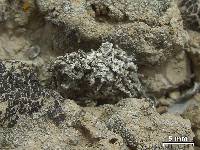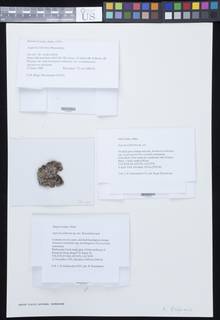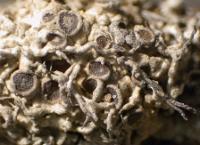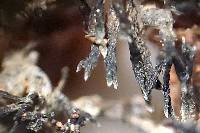
Consortium of Lichen Herbaria
- building a Global Consortium of Bryophytes and Lichens as keystones of cryptobiotic communities -
- Home
- Search
- Images
- Species Checklists
- US States: O-Z >
- US National Parks
- Central America
- South America
- US National Parks
- Southern Subpolar Region
|
|
|
|
Family: Megasporaceae
|
Nash, T.H., Ryan, B.D., Gries, C., Bungartz, F., (eds.) 2007. Lichen Flora of the Greater Sonoran Desert Region. Vol 3. Thallus: appressed fruticose, creeping, attached at several points along the lobes, mat-forming lobes: discrete, elongate, terete, contorted, usually short (5-10 mm) but up to 15 mm long, 0.4-1 mm wide; tips: distinctly different from the main thallus branches, often black and forked like snake's tongue surface: olive to brown to green-gray or ±green, turning bright to dull green when moist, without pseudocyphellae upper cortex: (20-)25-40(-45) µm thick, uppermost part ±brown, 5-10(-15) µm thick, with cells 5-8(-9) µm in diam.; cortex covered with an epinecral layer 5-23 µm thick, usually with crystals photobiont: chlorococcoid, cells ±round, 6-18 µm in diam. Apothecia: aspicilioid, rare, 0.5-1.5 mm in diam., slightly immersed to sessile disc: reddish brown to black thalline margin: entire, concolorous with thallus, rarely pruinose exciple: information lacking epihymenium: information of color lacking, N+ green hymenium: hyaline, 70-80 µm tall paraphyses: moniliform asci: clavate, 2-4-spored ascospores: subglobose, variable in size, 18-26 x 16-24 µm when 2 per ascus; 12-16 x 11-16 µm when 4 per ascus Pycnidia: rare, immersed, up to 0.3 mm in diam., with a black, punctiform, often ±elevated ostiole, 150-200 µm in diam conidia: filiform, 11-18 x (0.6-)0.8-1 µm Spot tests: cortex and medulla K- or K+ weakly and slowly turning yellow, P-, C-, KC- Secondary metabolites: without substances or sometimes with an unknown, K+ yellow substance. Substrate and ecology: on organic duff, moss and dead grass clumps, in shrub-steppe and grassland habitats World distribution: California, Oregon, Idaho, Utah, Washington, and Montana Sonoran distribution: not found in the Sonoran area, but a bit north of it, in Tulare County, California. Notes: Aspicilia filiformis is characterized by its fruticose thallus of filiform lobes with black and forked tips. The thallus is K- (or weakly yellow), in contrast to Aspicilia californica. The latter species contains norstictic acid and is K+ red, and usually has simple lobe tips. See Rosentreter (1998) for a more detailed description. The specimen from Tulare County is sterile. Pycnidia were not mentioned in the original description, but the Tulare specimen has several pycnidia. Technically the species is only known from north of the Sonoran region, but may well be found further south in the future. |
|
|
|
Powered by Symbiota


























